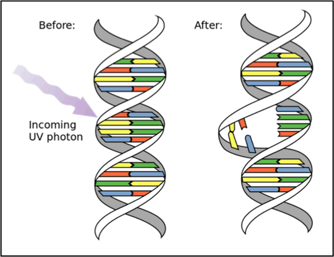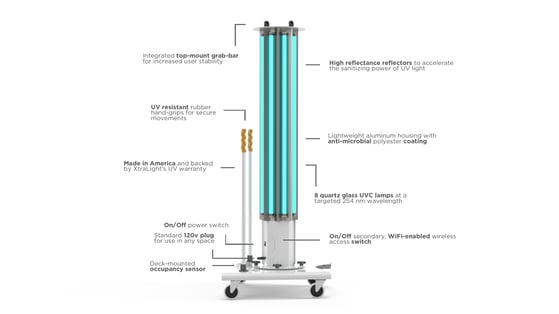This unsolicited report was prepared by Washington River Protection Solutions LLC for the U.S Department of Energy by E. B Wilkes. XtraLight extrapolated data from document RPP-RPT-62241 Rev. 01 to create this blog post. See the press release here
E. B. Wilkes, Washington River Protection Solutions LLC
September, 2020
Download the original document here:
“Ultraviolet Germicidal Irradiation (UVGI) has a definite future in the control of contagious diseases, and if applied on a widespread basis, it may be the key to controlling epidemics and pandemics. No other current technology has the capability, the adaptability, and the favorable economics to make it viable for an extremely wide variety of disease control applications.” (Kowalski, 2009).
(Figure 1. Radiology Department In Hospital For UV-C High Power Ultraviolet Disinfection)
Portable UV germicidal lamps have an excellent potential to disinfect Radiological Instrumentation Probes and Personnel Contamination Monitors
(PCMs), inactivating 99.999% of pathogens on solid, non-porous surfaces. The technology is proven against SARS and MERS Coronaviruses.
An XtraLight® UV-C Handheld Ultraviolet Disinfection System, model #UVCH240254WH, was purchased and tested August 26-27 and September
2-3, 2020. Tests were conducted to determine the feasibility of using this lamp to rapidly disinfect radiological instrumentation probes and
Personnel Contamination Monitors (PCMs). The irradiance readings, using a NIST-traceable radiometer, demonstrated that a sufficient fluence, or
radiant dose of Ultraviolet-C (UVC) to kill or inactivate 99.999% of many pathogens, would require the following times seen below on table 1.
(There was no response by the contamination monitoring instruments to the UVC, demonstrating that the instruments could be disinfected while
energized and immediately returned to service.)
| Alpha and Alpha/Beta Scintillation Probes | 10 Seconds |
| PCM Detector Panel | 10 Seconds |
| Argos™ 5AB Whole Body Surface | 1 Minute |
Table 1. Disinfection Times for Radiological Equipment using a UV-C Handheld
Of the studies of germicidal effectiveness of UVC, the ambulance test is the most applicable. It was found that a dose of 52.6 mJ/cm2 was required
to inactivate at least 99.9% B. subtilis spores on a solid surface which would inactivate 99.999% of many pathogens on a solid surface. This value of
52.6 mJ/cm2 will be the standard disinfection dose to be required when evaluating any UVC lamp.
Find: Time of irradiation to achieve 52.6 mJ/cm2.
Since 1 Joule = 1 Watt-second, find time to reach 52.6 mW-sec/cm2.
(52.6 mW-sec/cm2)/(5.54 mW/cm2) = 9.5 sec
This chart displays the mW/cm2 (Ultraviolet-C Irradiance) per second when held 1.5" from calculation paper with the x and y values being inches from the dead center of the lamps.
| -12" | -10" | -8" | -6" | -4" | -2" | 0 | 2" | 4" | 6" | 8" | 10" | 12" | |
| +4" | .366 | 2.11 | 3.36 | 4.02 | 4.24 | 4.31 | 3.90 | 4.52 | 4.34 | 4.60 | 3.59 | 2.24 | .302 |
| +2" | 0.647 | 2.99 | 7.23 | 8.68 | 9.06 | 9.04 | 9.06 | 9.03 | 8.87 | 8.61 | 7.60 | 3.06 | 0.599 |
| 0 | 0.995 | 3.87 | 8.09 | 9.42 | 9.81 | 9.84 | 10.1 | 10.1 | 10.1 | 9.66 | 9.10 | 3.73 | 0.942 |
| -2" | 0.386 | 2.76 | 6.90 | 9.01 | 9.34 | 9.18 | 9.23 | 9.07 | 9.01 | 8.55 | 7.72 | 2.76 | 0.418 |
| -4" | 0.906 | 2.18 | 3.50 | 3.45 | 4.50 | 4.03 | 4.06 | 3.56 | 3.92 | 3.38 | 2.96 | 1.87 | 0.663 |
Table 1.1 Irradiance Map of Lamp with Paper Base. (Units: mW/cm2 Inches from dead center of lamp)
Terms and Fundamental Quantities:
| Pathogens: | “Pathogens are any microbes that cause infection in humans and animals, and these include viruses, bacteria, and fungi.” (Kowalski, Section 1.8) |
| Germicidal: | “The term ‘germicidal’ implies that these UV systems destroy, kill, or inactivate microorganisms such as viruses, bacteria, and fungi. Technically, viruses are molecules, and so it is customary to refer to viruses as being inactivated rather than killed. In all cases, germicidal action means disinfection, and disinfection implies a reduction in the microbial population, whether in air, water, or on surfaces.” (Kowalski, Section 1.3) |
| Radiant Energy: | The energy associated with and transmitted in the form of waves. Examples: light, heat, X-rays, and gamma rays. Symbol: Q. Unit: Joule. Note: 1 Joule = 1 Watt-second |
| Radiant Flux: | The time rate of flow of radiant energy. Symbol: Φ. Unit: Watt. Mathematically: Φ=dQ/dt |
| Irradiance / Incident Radiant Flux Density: | The radiant flux incident on a surface. Symbol: E. Unit: mW/cm2. Mathematically: E=dΦ/dA |
| Emitted Radiant Flux Density / Radiant Exitance: | The radiant flux density emitted from a source, as a lamp. Symbol: M. Unit: mW/cm2. |
| Fluence / Radiant Dose: | Radiant energy deposited; for a surface, deposited per unit area. Unit: mJ/cm2, or mW-sec/cm2. |
| SARS-CoV-2: | Severe Acute Respiratory Syndrome-Coronavirus-2, or in early 2020, the “novel coronavirus.” The virus that causes Coronavirus Disease 2019 (COVID-19). (CDC 2020) |
| UVGI / Ultraviolet Germicidal Irradiation: | A disinfection method that uses UVC light to kill or inactivate microorganisms. |
Ultraviolet Radiation:
The full spectrum of ultraviolet radiation (UVR) can be classified into three
groups based on wavelength: ultraviolet A (UVA) (400-315 nm), ultraviolet B
(UVB) (315-280 nm), and ultraviolet C (UVC) (280-100 nm).” (Chang) UVA is
commonly known as black light and causes an immediate tanning effect to the
skin, UVB is the wavelength that causes suntan and sunburn, and UVC is the
wavelength that provides germicidal action.
(Figure 1.1 [when in] viruses, uracil takes the place of thymine. Inactivation of RNA viruses involves
cross-linking between the uracil nucleotides and the creation of uracil dimers.)
“UV wavelengths inactivate microorganisms by causing cross-link between
constituent nucleic acids. The absorption of UV can result in the formation of
dimers in DNA, which can lead to mutations or cell death. The primary dimers
formed in DNA by UV exposure are known as thymine dimers. The lethal effect
of UV radiation is primarily due to the structural defects caused when thymine
dimers form but secondary damage is also produced by cytosine dimers.”
(Kowalski, p. 21) See Figure 1.1 “In RNA …[when in] viruses, uracil takes the place
of thymine. Inactivation of RNA viruses involves cross-linking between the uracil
nucleotides and the creation of uracil dimers.” (Kowalski, p. 23)
“Worst Case” Threshold Limit Values (TLVs) for unprotected eyes and skin were
measured at 2, 4, 5, 6, 7, 8, 9, and 10 feet, with the unprotected worker staring
directly at the lamp output. TLVs were as follows:
- 2 feet: 8 seconds
- 4 feet: 27 seconds
- 5 feet: 42 seconds
- 6 feet: 1 minute
- 7 feet: 1 minute, 19 seconds
- 8 feet: 1 minute, 44 seconds
- 9 feet: 2 minutes, 15 seconds
- 10 feet: 2 minutes, 45 seconds
Approvals
| Title | Name | Date |
| Checker | Lewis, Steven S | 09/28/2020 |
| Clearance Review | Harrison, Sarah E | 10/12/2020 |
| Document Control Approval | Alvarez, Efren | 10/08/2020 |
| Originator | Wilkes, Ed B | 09/21/2020 |
| Other Approver | Uliano, Tony | 10/06/2020 |
| Radiological Control | Konzen, Kevin K | 10/06/2020 |
| Responsible Manager | Konzen, Kevin K | 10/07/2020 |
To see more information on XtraLight's UV-C products, please click here.
_________________________________________________________________________________________________________________________
References:
Alberts, B. (1970, January 01). Introduction to Pathogens. Retrieved October 13, 2020, from https://www.ncbi.nlm.nih.gov/books/NBK26917/
Berg, J. M. (1970, January 01). Amino Acids Are Encoded by Groups of Three Bases Starting from a Fixed Point. Retrieved June 01, 2020, www.ncbi.nlm.nih.gov/books/NBK22358/
(2017, December 06). SARS. Retrieved October 13, 2020, from https://www.cdc.gov/sars/index.html
(n.d.). Middle East Respiratory Syndrome (MERS). Retrieved October 13, 2020, from https://www.cdc.gov/coronavirus/mers/index.html
(n.d.). SARS-CoV-2 Viral Culturing at CDC. Retrieved October 13, 2020, from https://www.cdc.gov/coronavirus/2019-ncov/lab/grows-virus-cell-culture.html
(2020, September 02). NIOSHTIC-2 Publications Search - 20034387 - Ultraviolet germicidal irradiation - current best practices. Retrieved October 13, 2020, from https://www.cdc.gov/niosh/nioshtic-2/20034387.html
Cournoyer, M. (2018, March 01). Contamination control monitoring at the Los Alamos National Laboratory's Plutonium Facility. Retrieved October 13, 2020, from https://www.osti.gov/servlets/purl/1492670
Duan SM, Zhao XS, Wen RF, et al. Stability of SARS coronavirus in human specimens and environment and its sensitivity to heating and UV irradiation. Biomed Environ Sci. 2003;16(3):246‐255 https://pubmed.ncbi.nlm.nih.gov/14631830/
Jingwen C, Li L, Hao W. (2020). Review of UVC-LED Deep Ultraviolet Killing New NCP Coronavirus Dose. In Technology Sharing. (Hubei Sheng Technology Co., Ltd. www.researchgate.net/publication/339887436_2020_COVID
19_Coronavirus_Ultraviolet_Susceptibility
Kowalski, W., Bahnfleth, W., Raguse, M. and Moeller, R. (2020), The cluster model of ultraviolet disinfection explains tailing kinetics. J Appl Microbiol, 128: 1003-1014.
doi:10.1111/jam.14527 https://sfamjournals.onlinelibrary.wiley.com/doi/abs/10.1111/jam.14527
Kowalski, Wladyslaw & Walsh, Thomas & Petraitis, Vidmantas. (2020). 2020 COVID-19 Coronavirus Ultraviolet Susceptibility. 10.13140/RG.2.2.22803.22566. https://www.researchgate.net/publication/339887436_2020_COVID
19_Coronavirus_Ultraviolet_Susceptibility
Lodish, H. (1970, January 01). Viruses: Structure, Function, and Uses. Retrieved June 01, 2020, https://www.ncbi.nlm.nih.gov/books/NBK21523/
Lytle, D. C., & Sagripanti, J. L. (2008, March 18). Predicted Inactivation of Viruses of Relevance to Biodefense by Solar RadiationC. David Lytle. Retrieved May 29,
Organization, W. H. (2020). Coronavirus. Retrieved June 01, 2020, https://www.who.int/health-topics/coronavirus
Phan, M., Ngo Tri, T., Hong Anh, P., Baker, S., Kellam, P., & Cotten, M. (2018, December 15). Identification and characterization of Coronaviridae genomes from Vietnamese bats and rats based on conserved protein domains. Retrieved June
01, 2020, https://www.ncbi.nlm.nih.gov/pmc/articles/PMC6295324/
Ren Y, Li L, Jia YM. New Method to Reduce COVID-19 Transmission - The Need for Medical Air Disinfection is Now. J Med Syst. 2020;44(7):119. Published 2020 May 21. doi:10.1007/s10916-020-01585
8 https://pubmed.ncbi.nlm.nih.gov/32440893/
Walker CM, Ko G. Effect of ultraviolet germicidal irradiation on viral aerosols. Environ Sci Technol. 2007;41(15):5460‐5465. doi:10.1021/es070056u https://pubmed.ncbi.nlm.nih.gov/17822117/





